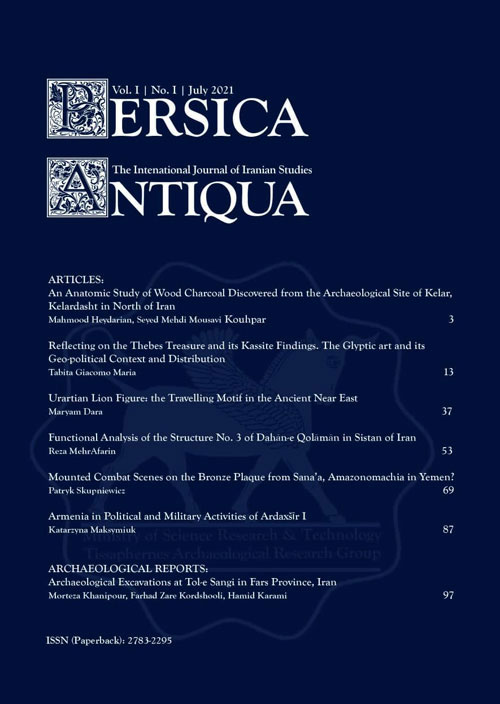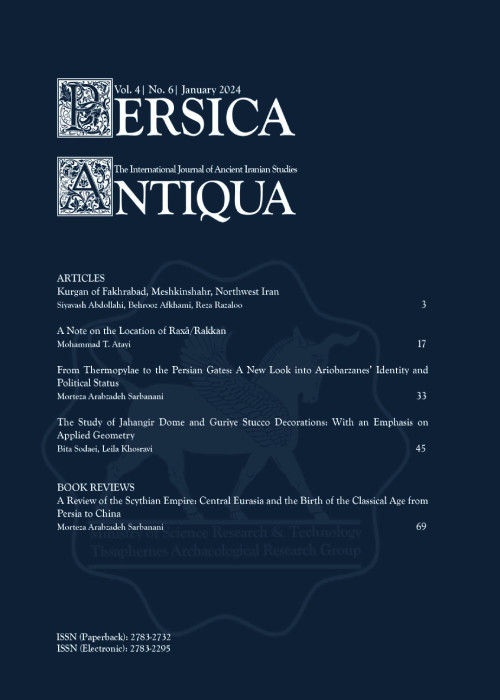فهرست مطالب

Persica Antiqua
Volume:2 Issue: 2, Jan 2022
- تاریخ انتشار: 1400/10/06
- تعداد عناوین: 5
-
-
Pages 3-25Iranian Azarbaijan and the southern Caucasus have relatively good environmental conditions for the formation of ancient settlements. These include the Lake of Urmia and the coasts of Aras in northwestern Iran and the basins of the Kora River, Mill-Moghan (mountainous areas) in the South Caucasus. The archaeological evidences and recent researches in the two geographical areas provide commonalities and cultural similarities of the period. The main purpose of this article is to introduce traditions of pottery and sites and determine the chronological sequence in the study areas. In order to achieve cultural interactions in the studied geographical area in the Chalcolithic period, the following questions are proposed: What is the status of chronological sequence in the two cultural domains? The main hypothesis in this regard is the existence of chronology is almost identical in the two geographical areas. How do the settlement layers and the sequence of habitation from the Neolithic to the Chalcolithic period in ancient sites show the issue of cultural continuity and transmission? The present writing is done by descriptive-analytical method. As a final result, it can be said that similarities and differences of archaeological data, including the features of pottery, architectural structure, burial etc. point out that by studying areas such as Dalma Tepe, Jolfa’s Kul Tepe, Khoy’s Dava Göz, etc. in Northwestern Iran and Leila Tepesi, Qalayeri, Poylu Tepe, etc in the South Caucasus region have been obtained and in terms of chronology, the millennium BC includes 5000 BC to 3700-3600 BC.Keywords: Chalcolithic, Azarbaijan in Northwest Iran, South Caucasus, Cultural Interactions, Chronology
-
Pages 27-36In Sistan, with an area of 8117 square meters, some 1660 archaeological sites have been explored during two phases of field surveys. The National Geographical Organization of the Armed Forces of Iran has divided Sistan into 22 geographical districts. The south of Qale Rustam Domain with an area of 295 square meters was the aim of second phase of investigation that could discover 280 archaeological sites. Most of them belong to Bronze Age. The site number 152 in the South of Qale Rustam Domain, which is located near the Iran-Afghanistan border with an area of 27000 square meters, was formed simultaneously with Shahr-e Sokhta. During the investigation, two stone objects resembling handbags, as well as a plenty of potsherds were found. The potsherds found at the surface level, both simple and designed are of the types found in phases 5-8 of Shahr-e Sokhta, which date back to the first half of the third millennium B.C. The specific function of these bags is still unclear, but seems to be weights or scale. However, based on chronological studies, these bags, like the other cultural proofs found around them especially pottery, can be attributed to the first half of the third millennium B.C.Keywords: Iran, Sistan, South of Qale Rustam Domain, Stone Weights, Pottery, Bronze Age
-
Pages 37-59North western Iran is one of the main focal points of Mannaean sites for reconstruction of this historical period. Discovery of the sites such as Tepe Qalaichi, Zendan-i soleiman, Tepe Rabat, Qal’e Bardineh and others in this region prove this claim. Tepe Bardeh-Konte, on the southern side of Uremia lake watershed, is located in Mahabad. This site with rock-cut structures including stairs, tunnel, pits and cut-walls is situated near the Fakhrigah rock-tomb. Studying and analyzing the pottery data from this region demonstrate that the site belongs to an Iron Age III settlement; the pottery collection from the site is similar to those from Mannaean sites such as Tepe Qalaychi, Tepe Rabat, Tepe Ziwiye, Qal’e Bardineh, Zendan-i Soliyman and Kul Tarike. This article is to report the first archaeological investigation results from the first season of survey and stratigraphy of Tepe Bardeh-Konte which yielded a Mannaean settlement period.Keywords: Tepe Bardeh-Konte, Mannaean, Uremia Lake, Iron Age, Pottery
-
Pages 61-76Climatic events, especially severe droughts, have played a key role in cultural evolution and the challenge of civilizations. Climate change, which affects the natural resources and, consequently, the health and subsistence system of human societies, can lead to increased violence, migration, war, and the spread of epidemics. The main purpose of this study is to investigate the possible effects of climate on important events of the Sassanid era. Extensive regions of the Near East and Central Asia have been more vulnerable to droughts, which often recurred during cooling periods, due to semi-arid to hyper-arid environmental conditions. From the second half of the fifth century AD with the beginning of the cold event of the early Middle Ages, the occurrence of droughts and cold waves caused famines and epidemics. These tensions seem to have triggered many social and political events in the Sassanid realm and neighboring regions. These conditions in the sixth and seventh centuries AD caused the gradual decline and eventual fall of the Sassanid government due to Arab invasions. Historical and paleoclimate studies show that successive wars with Central Asian invaders in dry periods, and the frequent outbreak of plague associated with falling temperatures, especially following the floods of the Tigris and Euphrates rivers in AD 628, were affecting factors in the dynasty’s weakness and collapse. Besides, some civil wars and revolts, such as the Mazdaki movement, can be considered as indirect effects of climate tensions that contributed to the gradual decline of the Sassanid Empire.Keywords: Sassanid, climate change, Drought, Famine, plague
-
Pages 77-84
In the early Islamic period, Khorasan was referred to as “Place of Sunrise” that stretched from the eastern side of the Lut Desert to the Hindukush Mountains. This region was divided into four parts or “quarters” of Neyshabour, Merv, Herat, and Balkh during the early centuries of Islam. The region that finally became the capital of Taherid dynasty was one of the important political, religious, and geographical centers during those years. A New York Metropolitan Museum’d expedition under Charles Carl Wilkinson was carried out on 3,500-hectare area of the ancient city of Neyshabour, from 1937 to 1948 AD.


